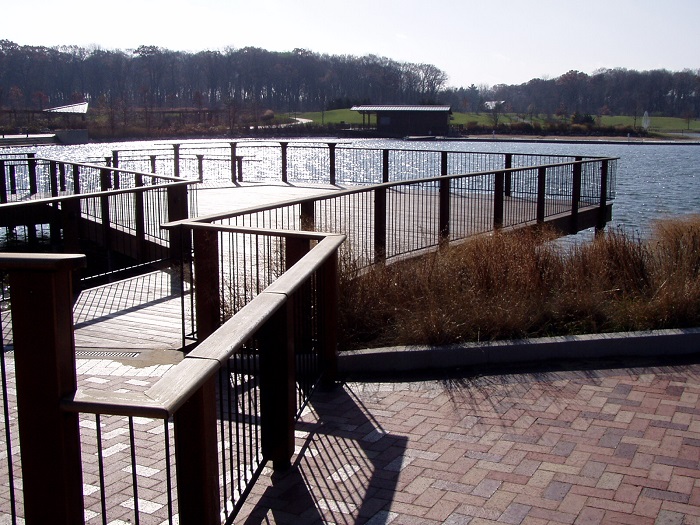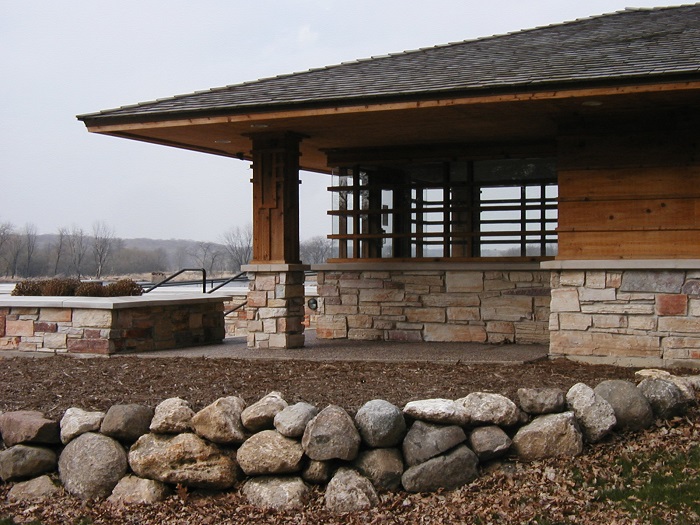Designing for Nature
Nature inspires us in our built projects. Nature is critical to our collective health and wellbeing. As architects, we carefully consider the impact of our designs on the environment. This is true for all of our projects, but particularly so when we work with clients who are stewards of nature, such as Lake County Forest Preserves.

As architects, we carefully consider the impact of our designs on the environment.
Spotlight on Lake County Forest Preserves
We are blessed to live and work in a community that provides abundant opportunities to access nature. Lake County Forest Preserves (LCFP) protects nearly 31,000 acres of natural land. They are focused on preservation, restoration, education, and recreation. Currently, they are working to create new trails and to improve public access and natural resource restoration at many preserves.
The LCFP offers a variety of natural environments, including fields, forests, marshes, beaches, farms, creeks, ponds, rivers, and lakes. Activities include canoeing and kayaking, dog exercise and training, bicycling, skating, snowshoeing and skiing, horseback riding and hiking, picnicking, bird watching, golfing, day camping, classes about plants and animals, native plant sales, and more.
Our families take advantage of our county’s many opportunities to access nature and recreation. We’re especially fans of the LCFP’s extensive trail system, open throughout the year. We appreciate that the preserves have been open throughout the pandemic. People have been able to exercise and enjoy nature, benefitting our community’s physical and mental health.
Considerations for Minimizing our Impact
Anything we do in nature is an intervention. We are very aware of this and strive to have minimal impact on natural areas during and after construction projects. At the same time, our clients want to provide the means by which people can access and enjoy our natural environments. This is a key consideration when working in natural areas, parks, and forest preserves.

Designing for Nature – Independence Grove Forest Preserve
- Carefully Accessing Remote Construction Sites
Another challenge involves gaining access to construction sites. Frequently, the site is in a remote area. For example, our clients may want to build a bridge over a creek far from a street or parking area. We need to think carefully about how construction crews are going to get to the construction site with minimal impact on the environment. In addition, we need to consider how to bring materials and machinery into the site. Distance from staging areas and parking will add to the project cost as well.
- Using Alternative Construction Methods & Materials
We want to make minimal changes to natural areas and this consideration will have an impact on the construction methods and materials we choose. As an example, we worked on a project in which a structure was to be built on soil with poor bearing capacity. Typically, we would have proposed traditional foundation systems and a large area of the site would have been disrupted. Because we want to minimize the site disruption in nature areas, we chose a non-traditional foundation system with minimal impact.
- Mitigating Runoff and Contaminants
Paving can create runoff that causes erosion and undesirable ponding. Asphalt paving also gradually leaches contaminants into the environment. Parked cars and trucks can contribute oil and debris to the surrounding soil. These are important considerations for any project, but even more so in fragile natural areas. We utilize planted swales and rain gardens to direct the water and contaminants in the desired direction and to absorb and filter it to mitigate potential issues.
- Evaluating Existing Conditions
Many times, nature is not as perfect as we find it. Our clients struggle to eradicate invasive species, reduce erosion and stagnant water, regrade paths that don’t drain, and much more. We work with them to decide how to change the site and what is the best change for all concerned. To some extent, the team acts as historians, digging into the past to understand the purpose of the land, how it was changed by people and natural forces, etc.
For example, we worked on a project that included an existing farm pond. Do we leave the dam and maintain the pond’s current ecosystem? Do we remove the dam to bring the area to a more natural state, but change the current ecosystem? These are challenges addressed every day by LCFP landscape architecture, construction, conservation, and program management professionals.

Designing for nature – Fox River Preserve, Barrington IL
Working with Lake County Forest Preserves
Over the last 30+ years, we’ve worked with the LCFP staff on diverse projects including bridges, shelters, restrooms, a marina, a gatehouse, decks, and a boat storage building. Our role has been as simple as providing advice on materials or as complex as providing the architectural design for a new building.
We always visit building sites to get a feel for the existing site conditions and the surrounding environment. Sometimes the site is really remote and only accessible by foot or bicycle. In remote sites, we work with the staff to provide public access to public lands.
Projects are always interesting and somewhat different from our other clients’ projects. For example, many of the LCFP structures are not monitored and the forest preserves are very popular, so the buildings and structures can take a beating. Because of this, durable, long-lasting materials and easy maintenance are very important. However, natural materials, energy savings, and sustainability are still valued and integrated into each project. On some projects, the client wants to include specific green practices and materials as a demonstration of sustainability. In every case, we create designs that are attractive, durable, in concert with nature, and that complement the natural environment.
Take advantage of our public lands and get out in nature! Explore the Lake County Forest Preserves soon. Check out the website for current facility availability, as there have been some closures due to construction projects and CDC health guidelines. Learn more about Lake County nature and history by visiting the Lake County Forest Preserves online blogs, Lake County Nature, and Lake County History. Learn more about Designing Access to Nature on our blog.

 Bleck & Bleck Architects
Bleck & Bleck Architects
